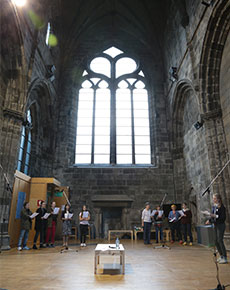AUT student represents NZ at Edinburgh Arts Festival

AUT PhD Candidate Olivia Webb and her artwork represented New Zealand at one of the largest art events in the United Kingdom, the Edinburgh Arts Festival.
Earlier this year Olivia was invited to create an artwork for the festival as part of the festival’s 2016 Commissions Programme. Her new artwork, Lapides Vivi, was launched at this year’s festival.
AUT Professor of Visual Arts Chris Braddock says, “This is an absolutely major achievement as its one of the largest art events in the United Kingdom. With a background as a choral singer, Olivia is presenting a multi-channel sound-based performance engaging with community spaces in her hometown of Christchurch affected by the devastating 2011 earthquakes.”
During the festival, Olivia also exhibited her 2014 work Voices Project; a multichannel sound installation originally made in collaboration with three Christchurch parishes who had each been affected by the devastating 2011 earthquakes. The installation acts as a ‘live monument’, documenting the social architecture with which small communities re-form and adapt in response to changing environments.
For her newest artwork, Olivia ran a similar series of open public choral workshops, inviting Edinburgh locals and visitors to contribute their voices to a new sound work for the historic Trinity Apse, where Voices Project has been exhibited.
Recordings from the public workshops were used to make Lapides Vivi.
She says, “Over the past three weeks I lead five open-invitation choral workshops in which participants have revived - through song and sound - the Gregorian hymn painted into the medieval altar piece by Hugo van der Goes, for the original Trinity College Kirk. My new work, Lapides Vivi (Living Stones) was made with recordings taken from each workshop.”
Lapides Vivi, is a response to the extraordinary history of Trinity Apse; a fragment of a medieval 15th century kirk that was dismantled to make way for the railway and partially reconstructed on its current site. The project reflects on ideas of displacement, and sheds light (through sound) on social stories embedded in solid architectural forms.
She says, “Coming from New Zealand where our architecture is ‘young’ compared to the long history embodied in monuments and heritage sites in Edinburgh, it is remarkable to me that a space like Trinity Apse sits empty for most of the year.”
“In this respect, the workshops have been a way to question the significance or relevance of these spaces to people today. I was interested in creating a situation and opportunity for people to momentarily reclaim an overlooked historic site, and I very interested in who might attend such an event – it was possible that no one would come!”
She says, “What you hear in the final work is over 100 different voices singing together across time; a fading music resounding in what is otherwise a silent space.”